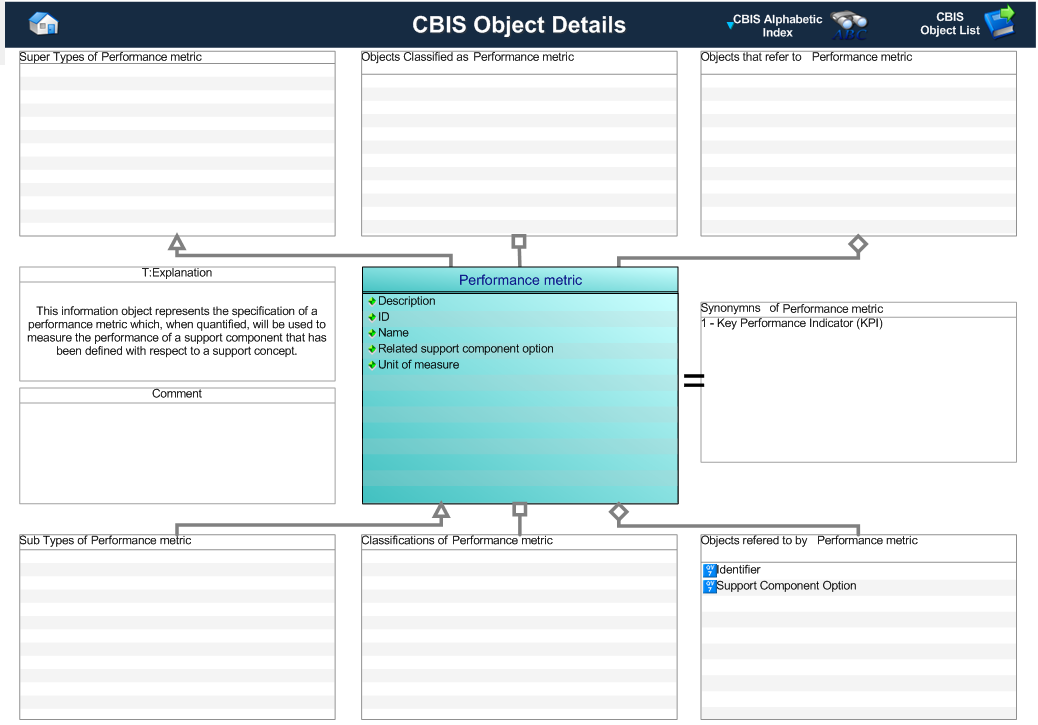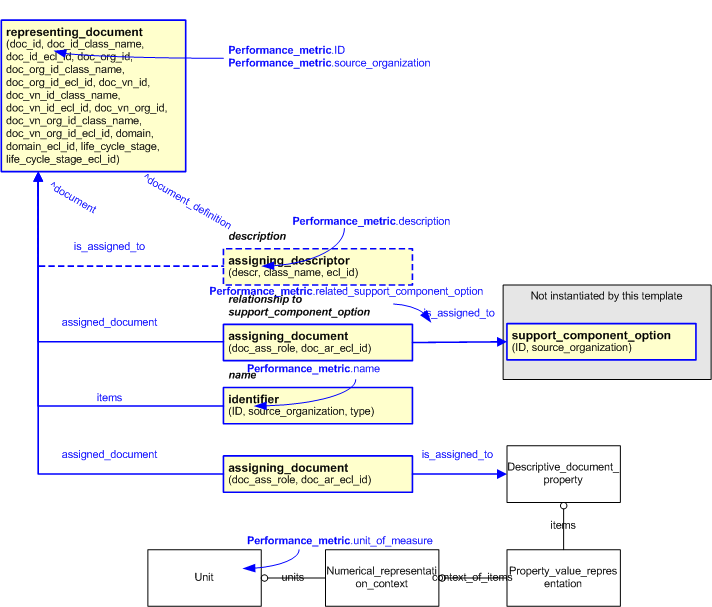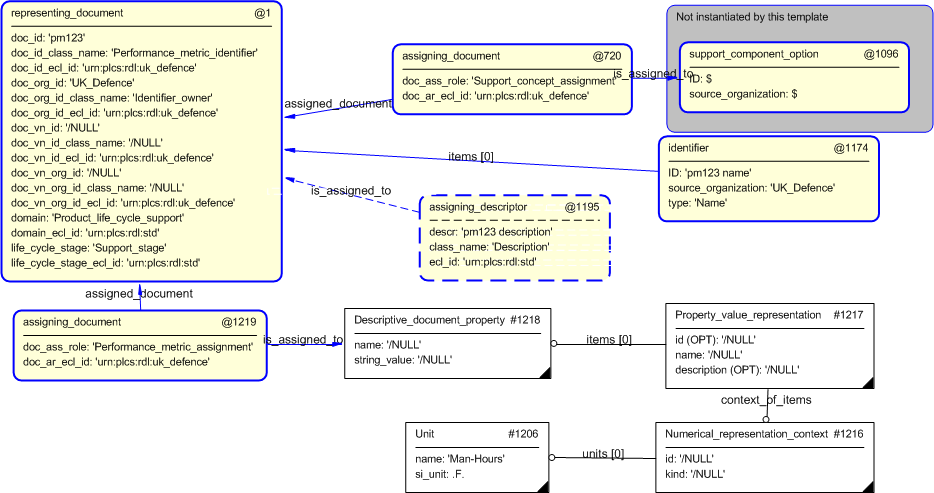Template:— performance_metric (perf_met)
Context:— UK_Defence |
Date: 2009/04/17 10:29:33
Revision: 1.2
|
This section specifies the template performance_metric.
NOTE
The template has been defined in the context of
UK_Defence.
Refer to the business context for details of related templates.
NOTE
An explanation of a template and the associated instantiation path is
provided in the
Template overview
section.
This template describes how to represent the specification of a performance metric which,
when quantified, will be used to measure the performance of a support component that has been defined with respect to a support
concept.
The performance metric business object is used by those UK_Defence Data Exchange
Specifications that require information about the specification of a performance metric which, when quantified, will
be used to measure the
performance of a support component that has been defined with respect to a support concept.
Figure 1 — Graphical Representation for Business Object Performance Metric
Performance Metric:
The definition of a Performance Metric object is:
Data about the specification of a performance metric.
|
Attribute name
|
Attribute description
|
Attribute type
|
Optionality
|
| Description |
This is the description of the performance metric. |
Intrinsic |
Optional |
| ID |
This is the identifier of the performance metric. |
Identifier |
Mandatory |
| Name |
This is the name of the performance metric.
EXAMPLE: Annual cost, Availability
|
Intrinsic |
Mandatory |
| Related support component option |
This is the reference to the support component option for which the performance metric is defined. |
Relationship to Support Component Option |
Mandatory |
| Unit of measure |
This is the Unit of measure. |
Intrinsic |
Mandatory |
Table 1 — Performance Metric attribute details
The EXPRESS-G diagram in
Figure
2
shows the templates and EXPRESS entities that are required
to represent the template
"performance_metric".
The text highlighted in blue shows the template parameters.
Figure 2 — An EXPRESS-G representation of the Information model for performance_metric
The graphic for the template to be used in other EXPRESS-G diagrams
is shown in Figure
3
below.
Figure 3 — The graphical representation of the performance_metric template
The following input parameters are defined for this template:
This is the description of the performance metric.
This is the identifier of the performance metric.
The organization that created the performance metric. Additionally
a Person or Information System could be defined when either of these are the source; see Identifier template.
This is the name of the performance metric.
This is the reference to the support component option for which the performance metric is defined.
This is the Unit of measure.
The following reference parameters are defined for this template:
Allow the
Document
entity instantiated in this path to be referenced when this template is used.
Note: The
Document
entity can be referenced in a template path by:
%^target = $performance_metric.doc%
where
target
is the parameter to which the
Document
is bound.
Allow the
Document_definition
entity instantiated in this path to be referenced when this template is used.
%^target = $performance_metric.doc_def%
The following parameter combinations specify a uniqueness constraint:
Unique constraint: Performance_metric
Each instance of the
entity
(
Document)
within the data set shall be uniquely identified
by a combination of the following parameters on this
template (performance_metric) namely:
ID,
name,
related_support_component_option.
The
instance is
referenced by the following template parameter:
doc.
The instantiation path shown below specifies the entities that are to be
instantiated by the template.
A description of templates and the syntax for the instantiation path is
provided in the
Templates Help/Information section.
-- Instantiate a document /
representing_document(
doc_id=@ID,
doc_id_class_name='Performance_metric_identifier',
doc_id_ecl_id='urn:plcs:rdl:uk_defence',
doc_org_id=@source_organization,
doc_org_id_class_name='Identifier_owner',
doc_org_id_ecl_id='urn:plcs:rdl:uk_defence',
doc_vn_id='/NULL',
doc_vn_id_class_name='/NULL',
doc_vn_id_ecl_id='urn:plcs:rdl:uk_defence',
doc_vn_org_id='/NULL',
doc_vn_org_id_class_name='/NULL',
doc_vn_org_id_ecl_id='urn:plcs:rdl:uk_defence',
domain='Product_life_cycle_support',
domain_ecl_id='urn:plcs:rdl:std',
life_cycle_stage='Support_stage',
life_cycle_stage_ecl_id='urn:plcs:rdl:std')/
%^doc = $representing_document.document%
%^doc_def = $representing_document.document_definition%
-- related_support_component_option /
assigning_document(
doc_ass_role='Support_concept_assignment',
doc_ar_ecl_id='urn:plcs:rdl:uk_defence',
assigned_document=^doc,
is_assigned_to=@related_support_component_option)/
-- Name (mandatory) /
identifier(
ID=@name,
source_organization=@source_organization,
type='Name',
items=^doc)/
-- [optional description] /
assigning_descriptor(
descr=@description,
class_name='Description',
ecl_id='urn:plcs:rdl:std',
is_assigned_to=^doc)/
-- Unit UnitUnit.name ->
@unit_of_measureUnit.si_unit = '.F.'
%^unit =
Unit%
-- Numerical_representation_context Numerical_representation_contextNumerical_representation_context.id = '/NULL'
Numerical_representation_context.kind = '/NULL'
Numerical_representation_context.units ->
^unit
%^num_rep_con =
Numerical_representation_context%
-- Descriptive_document_property Descriptive_document_propertyDescriptive_document_property.name = '/NULL'
Descriptive_document_property.string_value = '/NULL'
%^desc_rep_prop =
Descriptive_document_property%
-- Property_value_representation Property_value_representationProperty_value_representation.id = '/NULL'
Property_value_representation.name = '/NULL'
Property_value_representation.description = '/NULL'
Property_value_representation.items ->
^desc_rep_prop
Property_value_representation.context_of_items ->
^num_rep_con
-- relationship to unit /
assigning_document(
doc_ass_role='Performance_metric_assignment',
doc_ar_ecl_id='urn:plcs:rdl:uk_defence',
assigned_document=^doc,
is_assigned_to=^desc_rep_prop)/
The following entities are instantiated with attributes as specified:
The instance diagram in Figure
4
shows an example of the EXPRESS entities and templates that are instantiated by the template:
/performance_metric(description='pm123 description', ID='pm123', source_organization='UK_Defence', name='pm123 name', related_support_component_option='@1096', unit_of_measure='Man_Hours')/
(an illustration of the consolidated performance_metric template is shown in
Figure
5 below.)
Figure 4 — Entities instantiated by performance_metric template
The instance diagram in
Figure
5
shows the graphic symbol for the template that is to be
used in other instance diagrams. The example template is:
/performance_metric(description='pm123 description', ID='pm123', source_organization='UK_Defence', name='pm123 name', related_support_component_option='@1096', unit_of_measure='Man_Hours')/
Figure 5 — Instantiation of performance_metric template
Characterizations
No common characterizations of the template
performance_metric
have been identified. However, the ISO 10303-239 EXPRESS model
may enable other assignments to the entities instantiated by the template.




